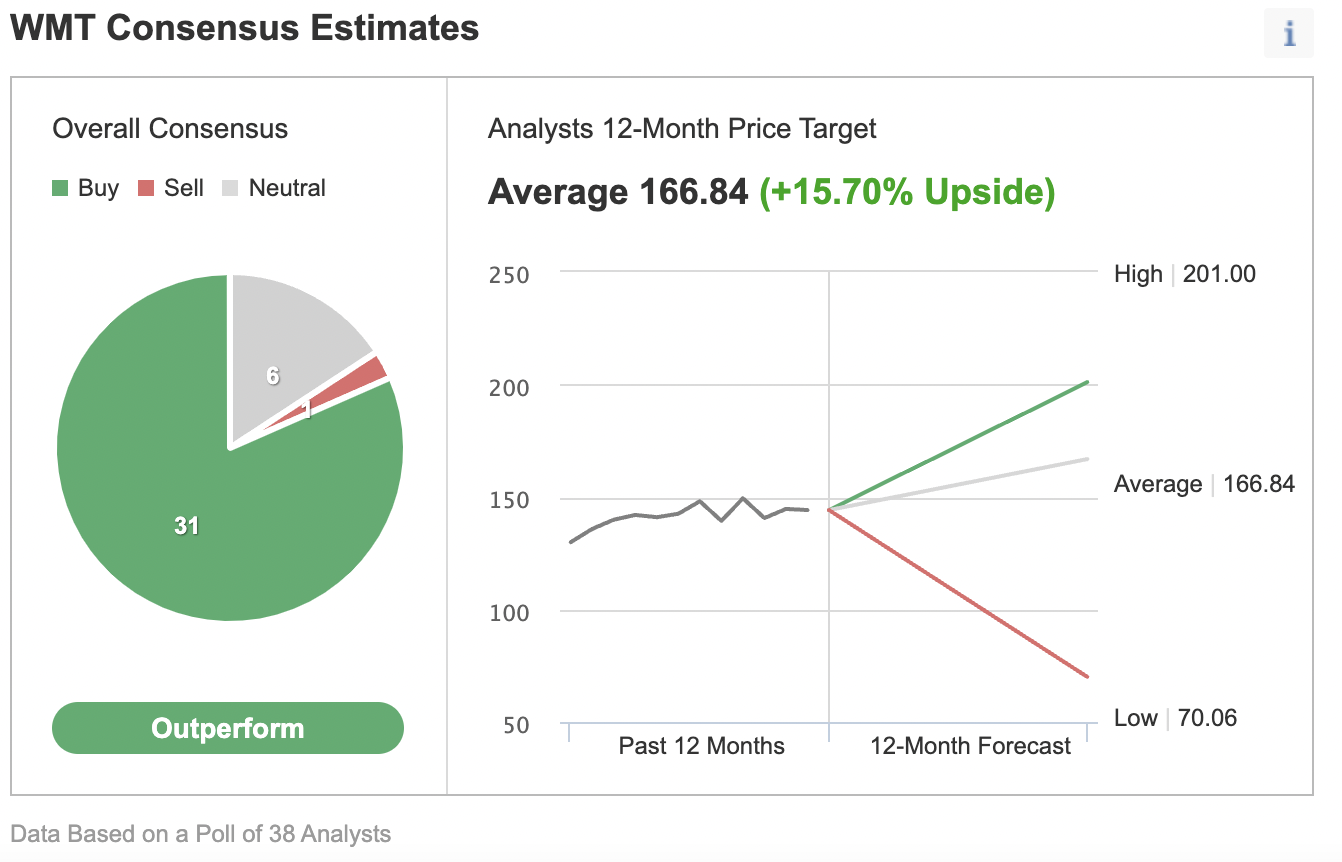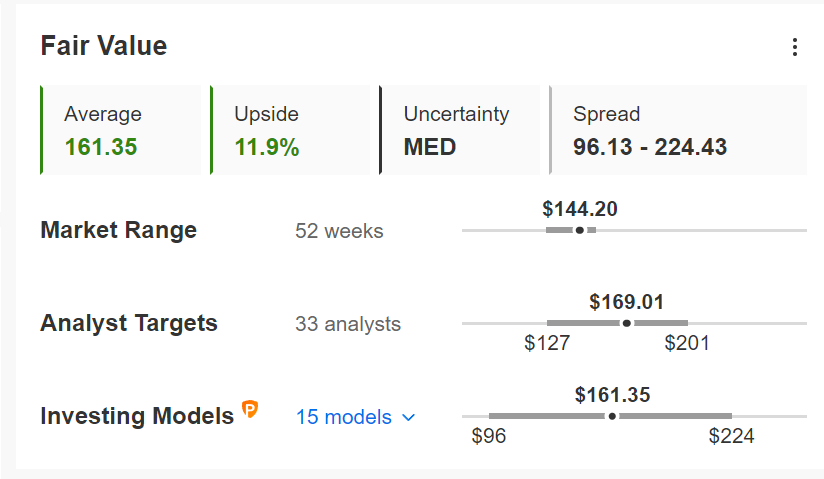Investors in retail giant Walmart (NYSE:WMT) have not had much to write home about in the past 12 months. WMT stock is down about 3.5% over the past year. By comparison, the Dow Jones U.S. Retailers returned 12.6%.

On Aug. 18, WMT shares went over $152 to hit a record high. The stock’s 52-week range has been $126.28 - $152.57, while the market capitalization stands at $400.5 billion.
Seasoned investors have been watching the battle between Amazon (NASDAQ:AMZN) and Walmart—a clash of titans, leaders in the retail and e-commerce sectors. Both names have also started offering financial services to customers.
One area in which Walmart sets itself apart from Amazon is ‘click-and-collect,’ whereby customers pick up their orders either in-store or curbside. Recent metrics show:
“Walmart scored 25.4% of all click-and-collect orders in 2021 — the largest share of any U.S. retailer.”
Walmart released robust Q3 figures on Nov. 16. For financial reporting purposes, its fiscal year ends on Jan. 31. Quarterly revenue increased 4.3% year-over-year to $140.5 billion. Adjusted EPS was $1.45 versus $1.34 achieved a year ago.
On the results, CEO Doug McMillon said:
“Our momentum continues with strong sales and profit growth globally. Our omni-channel focus is pushing digital penetration to record levels. We gained market share in grocery stores in the U.S., and more customers and members are returning to our stores and clubs around the world.”
Management also raised its Q4 outlook. It now expects a 5% increase in U.S. comparable sales. FY 2022 adjusted EPS guidance also increased to $6.40, up from the $6.20-6.35 band.
Prior to the release of the quarterly results, WMT stock was around $145. Since then it has been choppy, trading in an approximate range of $135 and $148. As we write, the stock is around $144.30, and the current price supports a dividend yield of 1.53%.
Next Move In WMT Stock?
Among 38 analysts polled via Investing.com, Walmart shares have an “outperform” rating, with an average 12-month price target of $166.84. Such a move would imply an increase of about 15.5% from the current level. The target range is between $70.06 and $201.

Chart: Investing.com
Similarly, according to a number of valuation models like those that might consider P/E or P/S multiples, dividends or terminal values, the average fair value for WMT stock via InvestingPro stands at $161.35.

Source: InvestingPro
However, many investors are likely to be nervous about how WMT shares might fare in the coming weeks given both the recent volatility in broader markets, as well as the supply-chain issues that retailers still face. In addition, we are about to begin a busy earnings season that could see declines in retail names.
In the short run, we expect Walmart stock to potentially drop below $140, possibly toward $135.
Following such a potential decline, WMT shares are likely to trade sideways for several weeks until they establish a base, possibly around $145, and then start a new leg up.
Therefore, Walmart bulls with a two- to three-year horizon who are not concerned about short-term volatility could consider buying the stock around these levels for long-term portfolios. Others, who are experienced with options strategies and believe there could be further declines in WMT shares, might prefer to try a bear put spread.
However, most option strategies are not suitable for all retail investors. Therefore, the following discussion is offered for educational purposes and not as an actual strategy to be followed by the average retail investor.
Bear Put Spread On WMT Stock
Price at time of writing: $144.30
In a bear put spread, a trader has a long put with a higher strike price and a short put with a lower strike price. Both legs of the trade have the same underlying stock (i.e. Walmart) and the same expiration date.
The trader wants Walmart stock to decline in price. However, in a bear put spread, both the potential profit and the potential loss levels are limited. Such a bear put spread is established for a net cost (or net debit), which represents the maximum loss.
Let’s look at this example:
For the first leg of this strategy, the trader might buy an at-the-money (ATM) or slightly out-of-the-money (OTM) put option, like the WMT Mar. 18, 140-strike put option. This option is currently offered at $3.25. It would cost the trader $325 to own this put option that expires in slightly more than two months.
For the second leg of this strategy, the trader sells a WMT put, like the WMT Mar. 18, 135-strike put option. This option’s current premium is $1.90. The option seller would receive $190, excluding trading commissions.
Maximum Risk
In our example, the maximum risk will be equal to the cost of the spread plus commissions. Here, the net cost of the spread is $1.35 ($3.25 – $1.90 = $1.35).
As each option contract represents 100 shares of the underlying stock, i.e. WMT, we’d need to multiply $1.35 by 100, which gives us $135 as the maximum risk.
The trader could easily lose this amount if the position is held to expiry and both legs expire worthless, i.e., if the Walmart stock price at expiration is above the strike price of the long put (or $140 in our example).
Maximum Profit Potential
In a bear put spread, potential profit is limited to the difference between the two strike prices minus the net cost of the spread plus commissions.
So in our example, the difference between the strike prices is $5 ($140 – $135 = $5). And as we’ve seen above, the net cost of the spread is $1.35.
The maximum profit, therefore, is $3.65 ($5.00 – $1.35 = $3.65) per share, less commissions. When we multiply $3.65 by 100 shares, the maximum profit for this option strategy comes to $365.
The trader will realize this maximum profit if the WMT stock price is at or below the strike price of the short put (lower strike) at expiration, or $135 in our example).
Short put positions are typically assigned at expiration if the stock price is below the strike price (i.e., $135 in this example). However, there is also the possibility of early assignment. Therefore, the position would need monitoring up until expiration.
Break-Even WMT Price At Expiration
Finally, we should also calculate the break-even point for this trade. At that price, the trade will not gain or lose any money.
At expiration, the strike price of the long put (i.e., $140 in our example) minus the net premium paid (i.e., $1.35 here) would give us the break-even WMT price.
In our example: $140 − $1.35 = $138.65 (minus commissions).
Bottom Line On Walmart Shares
We regard WMT stock to be a solid long-term choice for most portfolios. Despite the short-term choppiness in shares, the growth trajectory remains intact for this retail and e-commerce giant.
Still, WMT stock could come under further pressure during this earnings season. Therefore, a trading strategy as outlined above might be appropriate for traders with a bearish outlook on Walmart shares.
Which stock should you buy in your very next trade?
AI computing powers are changing the stock market. Investing.com's ProPicks AI includes 6 winning stock portfolios chosen by our advanced AI. In 2024 alone, ProPicks AI identified 2 stocks that surged over 150%, 4 additional stocks that leaped over 30%, and 3 more that climbed over 25%. Which stock will be the next to soar?
Unlock ProPicks AI